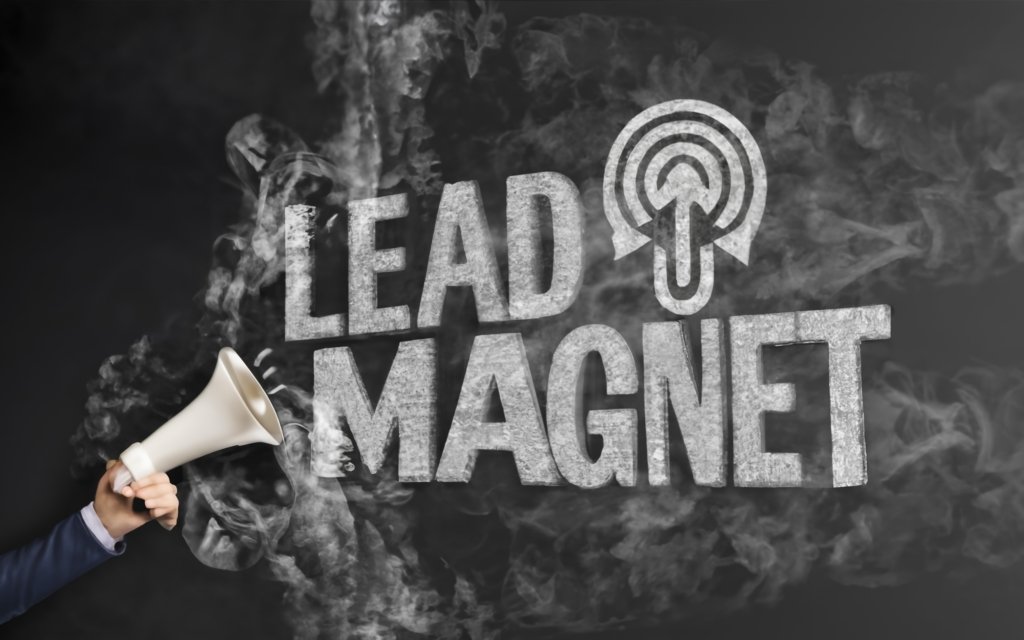Tired of letting promising leads slip through your fingers? Stop fishing blindly for buyers and sellers. Instead, use targeted lead magnets to hook qualified prospects and reel them in. This guide reveals 12 highly effective magnets you can dangle to capture more contacts and grow your real estate business.
Why Lead Magnets Matter for Real Estate Agents
In the competitive world of real estate, agents need to utilize every tool at their disposal to stand out and build their business. And one of the most powerful yet underutilized tools is the lead magnet.
The Importance of Staying Top-of-Mind with Prospects
The typical home buying process takes months from start to finish. From the initial research phase to touring homes and making offers, it’s rare for someone to find and purchase their dream home in just a few weeks.
That’s why it’s critical for agents to find ways to stay at the front of prospects’ minds throughout this lengthy process. You don’t want homebuyers to forget about you and suddenly realize, “Oh yeah, I was supposed to contact that one agent I met last month!”
Lead magnets help you continue nurturing relationships with potential clients over time. With an email list built through lead magnets, you can send periodic updates, share new listings, and provide market insights to prospects so you remain top-of-mind.
According to the National Association of Realtors, 88% of home buyers use the internet as an information source when searching for homes. So capturing those valuable leads online with magnets when interest is piqued is key.
How Lead Magnets Help You Build Relationships and Trust
Real estate is fundamentally a relationship-driven business. And trust is the foundation of any successful agent-client relationship.
But here’s the challenge: according to surveys, only 19% of people say they can trust real estate agents. Yikes!
So how do you get prospects to see you as a trusted advisor rather than a salesperson?
Lead magnets help build that layer of trust before you even meet someone. When you provide valuable, relevant information to potential clients for free, it establishes credibility and authority.
Rather than making broad, questionable claims about being “the best,” you prove your expertise with content they find genuinely useful.
And don’t underestimate the power of that first digital touchpoint. While impersonal, a well-crafted lead magnet shared via email or social media starts an important relationship.
Turning Website Visitors into Valuable Leads
Ask any agent – the number one asset for success in real estate is leads. Without leads, you have no one to build relationships with and no prospects to turn into clients.
And in today’s digital world, your website is often the first touchpoint between you and potential customers. But the challenge is that most visitors are just browsing or in the early research stages. They’re not ready to call you up or set an appointment.
This is where lead magnets bridge the gap, capturing that initial interest and driving conversions. Rather than letting 97% of visitors leave without contacting you, a lead magnet helps convert more of your traffic into subscribers and leads.
With an email or contact form standing between visitors and your content, you gather prospects’ contact info in exchange for delivering value. Now you can nurture them into clients.
So in summary, lead magnets help agents build awareness, trust, and relationships over those critical months it takes to buy or sell a home. They turn the cold traffic on your site into a warm pipeline of leads to expand your business.

Choosing the Right Lead Magnet for Your Goals
Not all lead magnets are created equal. The key is choosing or creating ones tailored to your specific goals and target audience. Buying a home is an emotional process tied to individual needs. So generic, one-size-fits-all magnets often don’t compel visitors to convert.
But when you appeal directly to the motivations and pain points of different prospect groups, you’ll see higher opt-in rates and more leads captured.
Lead Magnets for Home Buyers vs. Sellers
The first question to ask is: who are you trying to target – buyers or sellers? Each has unique needs a lead magnet can address:
For home buyers:
- Local market reports to gauge prices and competition
- Property listings under a certain budget
- Foreclosure listings
- Guide for first-time home buyers
- Checklist for attending open houses
- “How to win a bidding war” guide
For home sellers:
- Guide on preparing your home to sell
- Local home valuation tool
- Home staging tips
- Guide to maximizing sale price
- Tracker for showings and buyer feedback
- “How to select the right real estate agent” checklist
See the difference? Avoid the mistake of promoting the same vague magnet to both groups. Laser focus your offer based on each audience’s motivations.
Targeting First-Time Homebuyers
Another sub-group full of hot prospects is first-time homebuyers. This includes young professionals getting started, families moving up from rentals, and pretty much anyone purchasing their first property.
These buyers have some unique fears and uncertainties a savvy agent can address:
- Unsure how much they can afford
- Don’t understand mortgage pre-approvals
- Confused by down payments and closing costs
- Unfamiliar with contracts and paperwork
- Concerned about competitive offers and bidding wars
An excellent magnet is a comprehensive guide or checklist just for first-timers. Make it easy for them by clearly explaining each step and key terms. The more hand-holding, the better for these leads.
Appeal to Investors and Flippers
For experienced investors and flippers, do the opposite – don’t waste their time explaining basics. These prospects want inside data to identify up-and-coming neighborhoods, underpriced properties, and local fixer-uppers with potential.
Some magnet ideas that appeal specifically to investors:
- List of off-market wholesale deals
- Map of properties within 10-15% of market value
- Inventory of recently flipped homes
- Analysis of rental demand by neighborhood
- Survey of most requested amenities
The takeaway is to get specific and tailor your offers. Avoid anything generic. Craft lead magnets laser-focused on each niche audience you want to target.

Lead Magnet Ideas to Grow Your Real Estate Email List
Now let’s dive into 12 of the most effective lead magnets to help you rapidly build your email list and pipeline of prospects.
Local Market Reports and Analysis
One of the top lead magnets for real estate agents is an in-depth analysis of the local market. Home buyers and sellers are hungry for hyper-local data to inform their decisions.
A market report can cover details like:
- Average and median sales prices by neighborhood
- Number of active listings and months of housing supply
- Avg days on market and list-to-sale price ratios
- Historical appreciation and projections
- Demographic shifts and growth trends
- School district rankings and data
Compile relevant statistics, charts, and projections. While numbers are key, your unique spin is providing context and analysis.
Highlight interesting insights like:
- Neighborhoods seeing the fastest rising prices
- Areas with lowest inventory signaling a seller’s market
- Trends in list prices vs. final sale prices
Weave in stories and examples from your experience to illustrate key points and trends.
You can turn this into a short eBook, a slidedeck presentation, or an interactive web page or dashboard. The key is making the data easy to digest and tailored to your hyper-local area.
Free Home Valuation for Prospective Sellers
Home sellers are eager to know one thing – how much is my house worth? A lead magnet catering to that curiosity can be very enticing.
Now you likely can’t provide an official appraisal upfront. But you can offer a free comparative market analysis and price estimate based on similar homes sold nearby.
Ask for key property details like:
- Address
- Bed/bath count
- Square footage
- Lot size
- Special features
Then scour recently sold listings in the neighborhood and total up the averages. Identify comparable properties with similar beds/baths and features.
Provide a value range they could reasonably expect along with comps of similar homes backing up your estimate. Even a ballpark range gets them hooked and provides enormous value.
Just be sure to note it’s an initial estimate, not a formal appraisal. This primes sellers to contact you when ready to sell.
Guide to Preparing Your Home for Sale
Selling a home can be hugely stressful. Help homeowners ease the burden with a lead magnet guide to getting their house market-ready.
Include tips like:
- Best practices for decluttering and staging
- Low-cost fixes with the biggest impact
- How to highlight desirable features
- Neutralizing decor to appeal to masses
- Maximizing curb appeal for drive-bys
- Prepping for open houses and showings
You can provide general guidance while noting you offer more tailored tips upon request. This establishes your expertise so they think of you first when ready to list.
Guide to Winning Bidding Wars in Your Area
In many markets, bidding wars are common on desirable listings. Help anxious buyers get an edge with inside tips on winning in competitive offers.
Share strategies like:
- Finding out listing agent intel on seller preferences
- Structuring escalation clauses or over-asking price offers
- Waiving contingencies strategically
- Sending personalized letters to resonate emotionally
- Spotting “love letters” that hurt more than help
- Avoiding over-stretching your budget in the heat of the moment
This magnet reassures buyers you’ll battle in the trenches to help them land their dream home. They’ll turn to you when they find “the one” and expect heated competition.
Checklist for Buyers Visiting Open Houses
Weekend open houses are a cornerstone of real estate. But many buyers feel awkward navigating them alone.
Provide a downloadable checklist covering what to look for, ask about, and avoid doing when touring open houses:
- Key questions to ask the agent
- How long it’s been listed, number of offers, etc.
- What to look for beyond staging
- Decoding why certain upsgrades were made
- Signs of problems like leaks or foundation cracks
- Avoiding oversharing personal details and motivations
The checklist equips and empowers them to visit homes intelligently on their own time while positioniong you as an expert consultant.
Guide to Negotiating the Best Deal on a Home
One thing that intimidates many buyers is the negotiation process. How do you advocate for the best possible price without offending the seller?
An in-depth negotiating guide can help buyers push for the fairest deal:
- Researching local price trends and averages
- Formulating your initial offer strategically
- Knowing which terms to contest or concede
- Detailing contingencies and protections
- Smoothly handling counteroffers and rejections
- Sealing the deal once terms are settled
The confidence gained will make them eager to have you as their agent when it comes time to pull the trigger.
List of Homes Under a Certain Price Point
Cater to bargain shoppers and first-time buyers on a budget with a list of current listings under a chosen dollar amount. Segment further by neighborhood or bedrooms.
This captures price-conscious visitors ready to act fast when finding an affordable option. Make sure to note the list refreshes regularly as inventory turns over.
Once they find a home on your list they love, they’ll be primed to call you directly since you’re the expert on these properties.
Guide for First-Time Home Buyers
We covered lead magnet ideas tailored to first-time buyers earlier. But you can never overestimate the anxiety and uncertainty felt by this group.
Hold their hand through the entire purchase process:
- Pros/cons of buying vs. renting long-term
- How mortgages work and key loan terms decoded
- Types of down payment assistance programs
- Finding the right mortgage lender and pre-approval
- Estimating your true price range and costs
- Working with a real estate agent and their value
- Submitting offers and navigating negotiations
- Preparing for closing and moving day
The more knowledgeable first-timers feel, the more they’ll trust you as their agent advisor.
Monthly Newsletter with New Listings
Stay top-of-mind with prospects by emailing a monthly rundown of new real estate listings in their target city or neighborhood.
Include details like:
- Address, beds, baths, square footage
- List price and price per square foot
- Link to listing and photos
- Neighborhood name and highlights
Segment by buyer preferences like budget range when possible to send hyper-targeted options. This keeps you on their radar so they don’t forget to call when finding “the one”.
Access to Video Content and Virtual Home Tours
Videos are hugely engaging and mobile-friendly. Consider a lead magnet that unlocks access to video content on your site.
Options include:
- Curated library of home tour videos
- Neighborhood highlight reels
- Market forecast recordings
- Video tips for home buyers/sellers
- Recordings of your past live Q&A sessions
- Interviews with clients about their experiences
This content shows off your personality and expertise. The ongoing value builds trust and familiarity with potential clients over time.
Entry in a Contest or Giveaway
Tap into psychology with a lead magnet that offers entry in a fun contest, giveaway or raffle.
To attract buyers you can raffle:
- A home inspection
- Closing cost assistance
- Down payment funds
- Moving or furniture costs
- A home technology package
For sellers, prizes could include:
- Free staging consultation
- Professional photography session
- Landscaping services
- Handyman for fix-ups
- Cleaning service before listing
The prize ties to your services. But the contest ploy and chance of winning entices subscribers.
Free Consultation or Strategy Session
Offer a free 30 minute consultation, either remotely or in person, for new leads. This is your chance to demonstrate expertise and get prospects hooked.
Use the limited time to:
- Learn their needs and motivations
- Provide a market overview with latest data
- Discuss options tailored to their situation
- Address concerns transparently
- Outline your services and value proposition
- Book follow-ups to continue the relationship
Even without immediate business, you’ve built rapport and likability. Stay top of mind until they’re ready to fully engage your services.
In Summary
Rather than a spray-and-pray approach with uninspired magnets, put thought into matching highly targeted offers to different groups. Solve point problems and address pain points tailored to each type of prospect.
With the right message to the right people, your lead magnets will capture, nurture, and convert website visitors more effectively. Treat your list like gold to build relationships over time. Before you know it, you’ll have a pipeline flooding with both promising buyer and seller leads.

Promoting Your Lead Magnet Effectively
You’ve created an amazing lead magnet. Now you need to actually get it in front of people. An under-promoted magnet won’t capture many leads no matter how amazing it is.
Use these proven promotion strategies and channels to maximize your reach:
Website Landing Pages and Calls-to-Action
Your #1 asset for promoting lead magnets is your own website. Visitors are already interested if they’ve arrived at your site. Now give them an irresistible offer.
Create dedicated landing pages that make your magnet the hero. The page headlines and copy should clearly communicate:
- The tangible value being offered
- Precise steps to get the content
- A sense of urgency
Keep forms short with just name/email required to reduce friction. Add social proof elements like reviews and testimonials.
Then place clickable calls-to-action (CTAs) for the offer across your site. Some effective spots include:
- Right in your site navigation menu
- On your homepage below the fold
- On strategic category or section pages like “For Buyers”
- In sidebars or website widgets
- Pop-ups when visitors reach certain pages
- Page footers
This allows you to target visitors based on their interests while they’re engaged.
Social Media Contests and Lead Generation Ads
Promote your magnets on social media through contest posts, engaging images, and lead generation ads.
Contests require visitors to provide their details as an entry method. You can run contests like:
- Share this post and tag 3 friends for a chance to win a $500 gift card
- Comment your most loved home feature for a chance at a free staging consultation
- Sign up via the link in our bio to win a $250 furniture shopping spree
Ad platforms like Facebook make it easy to create lead gen ads right to a landing page. Target your audience with irresistible creatives driving opt-ins.
Direct Mail and Email Outreach Campaigns
Don’t just wait for site traffic – go directly to prospects already in your sphere of influence.
Send direct mail pieces like postcards to farm neighborhoods with eye-catching graphics and brief magnet offers. Follow up by email to interested recipients with specifics.
You can also email magnet offers to:
- Your current contact database
- Prior unconverted leads
- Past clients looking to buy/sell again
- Partners like lenders and contractors
Re-engage warm leads that previously slipped away with tailored outreach.
Retargeting Ads and Chatbots
Retarget visitors who engaged on your site but didn’t convert right away. Remarket to them across sites via ads re-promoting your magnet.
Chatbots allow you to offer magnets and capture data 24/7. Greet site visitors with a friendly bot. If they show interest, share your magnet and request contact details.
The key is staying top of mind and offering multiple touchpoints. Follow up your outreach across channels until lead magnets become second nature to think of you.
In summary, a multi-pronged promotion strategy ensures your magnets reach as many warm prospects as possible across web, social, email, and more. Put your magnet and call to action in front of your audience everywhere you can.

Continually Testing and Optimizing Your Lead Magnets
Don’t just create magnets and set them loose. To maximize performance, you need to continually test, measure, and refine them over time.
Treat your lead gen strategy like a scientific experiment, tracking results and tweaking variables to improve conversions.
Experiment with Different Offers and CTAs
A/B test 2+ versions of your lead magnet landing pages to see what resonates best with visitors.
Try switching up variables like:
- Headline and sub-headline
- Image used
- Description of the offer
- Call-to-action phrasing and placement
- Form field labels
This reveals how prospect respond to different approaches. You can also test sending traffic to two entirely different magnet offers to directly compare conversion rates.
Run tests for at least 2 weeks to gather enough data. The winner becomes your new control against which you can test further variants.
Track Lead Magnet Performance and Conversion Rates
Diligently track metrics to judge effectiveness and ROI of each lead magnet over time.
Key datapoints to analyze:
- Number of visitors shown magnet
- Clickthrough rate onto landing page
- Bounce rate from landing page
- Form submission conversion rate
- Quality of leads captured
Monitor trends to see if interest grows, plateaus, or wanes over weeks and months. Falling conversion rates signal it’s time to switch up your offer.
Survey Existing Leads on Needs and Interests
Go straight to your converted leads and new email subscribers to learn what magnets they’d find most helpful.
Send occasional quick surveys asking:
- How they heard about your magnet
- What attracted them to this offer
- Their current stage in the home buying/selling process
- What related topics they’d like content on
- Preferred formats like guides, videos, workshops
This intelligence directly from your audience is gold for crafting new magnets that better attract and convert the right prospects.
Refine Based on Lead Quality and Engagement
Pay attention to the quality and characteristics of leads your magnets generate. Assess factors like:
- How quickly and thoroughly they respond to follow-ups
- If they actively click links and offers sent
- Receptiveness to booking calls and meetings
- Overall lifecycle from lead to closed client
If your leads tend to be untargeted looky-loos, rework your magnet targeting and outreach. But responsive, high-converting leads mean you’ve built an effective magnet audiences crave.
By continually optimizing your lead gen process, you’ll capture more prospects in less time. And meet your growth goals faster through the power of magnets.

Key Takeaways
- Lead magnets help real estate agents stay top-of-mind with prospects during the lengthy home buying and selling process. They build relationships and trust with potential clients over time.
- Choose specific lead magnet offers that appeal directly to home buyers vs. sellers. Target different groups like first-time buyers and real estate investors.
- Effective magnets provide highly valuable information like market reports, home valuation tools, checklists, and guides tailored to each audience.
- Promote your lead magnets through dedicated landing pages, social media, and ads. Continually test and optimize different headlines, offers and CTAs.
- Monitor performance to identify which magnets capture quality leads that convert at the highest rates. Refine based on lead engagement and feedback.
- Once you build your email list, nurture subscribers with helpful content to stay top-of-mind. Respond promptly when a hot lead is ready to connect.
- With the right lead magnet strategy, you can capture website visitors and turn them into lifelong happy clients who refer others.
Frequently Asked Questions
What types of lead magnets work best for real estate agents?
Some of the most effective magnets are local market reports, home valuation tools, checklists, and guides tailored to home buyers or sellers. Offer valuable information that establishes your expertise.
How do I choose the right lead magnet for my audience?
Tailor your magnet specifically to home buyers vs. sellers, and even more targeted groups like first-time buyers or real estate investors. Address their unique motivations and challenges.
What’s the best format for a lead magnet?
Formats like downloadable PDF guides, email courses, video content, and tools/calculators tend to convert well. Test different options to see what your prospects most respond to.
Where should I promote my lead magnets for real estate?
Use your website, social media, paid ads, email campaigns, direct mail, and retargeting. Focus on channels where you can target prospects by their interests and intent signals.
How do I create an effective landing page for my magnet?
Your landing page should clearly communicate the value offered in exchange for an email address. Use urgency and social proof. Keep forms simple with just name and email required.
What’s the best practice for following up with lead magnet subscribers?
Add them to an email nurture sequence that continues providing value. Build the relationship with helpful, non-salesy content that keeps you top-of-mind.
How can I ensure my magnets generate high-quality leads?
Test different offers and target different demographics to attract the right prospects. Assess lead quality based on responsiveness and engagement. Refine your magnet or outreach accordingly.
When should I reach out more directly to leads to convert them?
Once a lead actively engages, like opening most of your emails or clicking links, they’re warmed up. Schedule a consultation to establish a direct relationship.
How do I track the performance of my lead magnets?
Analyze metrics like impressions, clickthrough rate onto landing pages, bounce rate, and most crucially – conversion rate. Continually optimize magnets to improve conversions.

